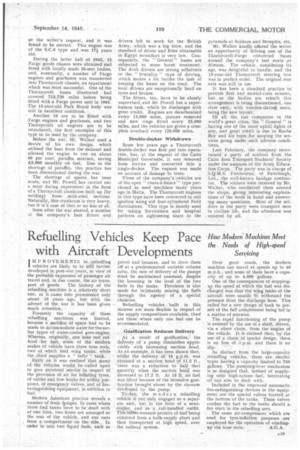Refuelling Vehicles Keep Pace with Aircraft Developments
Page 21

If you've noticed an error in this article please click here to report it so we can fix it.
How Modern' Machines Meet the Needs of High-speed Servicing
I MPRO VE MENTS in refuelling vehicles are likely to be still further developed in post-war ,years, in view of the probable expansion of passenger air travel and, in due course, the air transport of goods. The history of the refuelling machine is a relatively short One, as it came into prominence only about 10 years ago, but with the advent of the war it has been given much attention.
Formerly the capacity of these refuelling machines was limited, because a sacrifice of space had to be made to accommodate water for the earlier types of water-cooled aero-engine. Whereas, originally, one hose reel sufficed ;.for fuel, some of the modern makes of vehicle have three .hose reels, two of which feed wing tanks, while the third supplies a " belly " tank.
,Early on it was realized that many of the vehicles would be called upon to give univerSal service in respect Of the provision of air for inflating tyres, of cables and tow hooks for utility purposes, of emergency valves, and of fireextinguishing equipment, in addition to fuel. ••
Modern American practice reveals a number of fresh desians. In cases where three fuel tanks nave to be dealt with at one time, two hoses are arranged at the rear of the vehicle, and one runs from a compartment on the: side. In order to Mix two liquid fuels, such as
petrol and benzene, and to draw them off at a predetermined variable volume ratio, the rate of delivery of the pumps must be maintained constant, despite the lowering in the level of the two fuels in the tanks. Provision is also made for intimately mixing the fuels ' through the agency of a special chamber.
Refuelling vehicles built in this manner are More flexible in respect of the supply compositions available, tharf are those where only one fuel can be accommodated.
. Gasification Reduces Delivery
. .
As a result of gasification,' the delivery _of a pump diminishes appreciably with increasing suction head. an example, it has been shown that, whilst the delirery of 19 g.pari. was attained at a suction head iy± 11.2 ft., there was a reduction to 'half that quantity when the suction head was increased to 17.2 ft. At 18 ft. no fuel was lifted because of the intensive gasification brought about. by the vanillin "developed by the pump.
To-day, the modern refuelling vehicle is not only engaged as a separate unit but in the form of a semitrailer, and as a , rail-handled outfit. This laffermeasure permits of fuel being obtained from a•bulk-supply plant and then transported at high speed, over the railway -system. Over good roads, the modern machine can travel at speeds up to 40 m.p.h., and some of them have a capacity of up to 4,000 gallons.
One of the consequences of steppingup the speed at which the fuel was discharged was that the wing tanks 'Of the aircraft were unable tb withstand the pressure from the discharge hose. This called for a new design of tank to permit of the full complement being fed in a matter of minutes.
The rapid functioning of -the pump is assisted by the use of a shaft, driven,
• I
via a silent chain, from the• engine of the vehicle. It is claimed that, by the use 'of a chain .of special design, there
is no loss of and there is no slip. .
As distinct fromthe large-capacity • refuerring vehicles, there are smaller types having a 'capacity limited to 750 gallons. The pumping-over mechanism is so designed that, instead of supplying only high-octane fuel, lubricating oil can also be dealt with.
Included' iii the improved automatic fire-extinguishing devices in the equipnient are the special valves located at the bottom of the tanks. These valves confine the fuel to the tanks should a, fire start in the refuelling area.
_ The same air-compressorswhich are used for tyre-inflation purposes are employed for the operation of winding , up the hose reels. '




















































